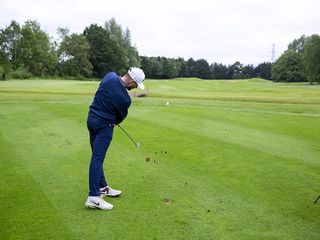Like most amateurs, I am willing to try almost anything to get better at golf. As a high-handicapper, I found the process of having golf lessons extremely beneficial, but I wondered if there was something else that could help me to better understand my swing and overall game.
I decided to speak to my club’s PGA Professional, Glen Ient, who offered me the chance to take part in a TPI Screening. This simple process took around 30 minutes, and involved carrying out a series of golf-related movements that Glen (as a TPI-certified coach) assessed and graded.
On completion, a ‘golf fitness handicap’ is generated, and participants are offered a series of exercises to help improve any potential areas of weakness.
I have always been fairly proficient at most sports, and I would describe myself as relatively fit, but this experience allowed me to understand how my fitness, mobility and flexibility is impacting my ability to play my best golf – and let me tell you, the results were fascinating…
What Is A TPI Screening?
TPI stands for Titleist Performance Institute, developers of the golf specific screening that examines the movement of golfers at every level, and is simply a method of measuring the efficiency in which a golfer swings the club.
I took part in the level 1 screening, which required me to demonstrate 16 golf specific movements. Each of those movements were graded as red, amber or green, and a profile was created based on my results.
The 16 areas included movements such as pelvic tilts, torso rotations, wrist hinges and overhead deep squats, all of which were demonstrated by Glen prior to me attempting them.
The screening also provides a rationale as to why each movement links to your golf swing or performance. For example:
“The Pelvic Tilt Test assesses overall mobility of the hips and lumbar spine as well as the ability to control the position of pelvic posture. The ability to move and control the position of the pelvis is crucial for optimal power transfer from the lower body to the upper body during the golf swing”.
The results of my TPI Screening indicated a couple of areas for development in my mobility and fitness
(Image credit: Barry Plummer)
The screening uses the information entered by the TPI-certified Pro to predict your swing characteristics. This information highlights certain tendencies in your golf swing, such as the chicken wing, flying elbow, ‘C’ or ‘S’ posture, and early extension, and grades whether your fitness, mobility and flexibility make you a high, medium or low risk for these characteristics.
The exercises assigned on completion are easy to carry out, and often require minimal or no equipment. Instructional videos on each exercise are also provided.

The results of my TPI screening indicated that I was likely to set-up with an ‘S’ shape posture, produce an over-the-top swing and extend early
(Image credit: Barry Plummer)
What Do The Results Tell Me?
After completing all 16 movements, I was eager to learn my golf fitness handicap. The app ticked through the numbers and quickly generated my score.
My golf fitness handicap is almost 20 shots better than my WHS index, providing me with the confidence that physical limitations aren’t preventing me from making progress on the course. I was assessed as a 10-handicap, agonisingly close to single-figures (something I can only dream of at this point), but nonetheless I was very pleased with the outcome overall.
I scored red in just one out of 16 movements, the ’90/90′. This links to the external rotation of my shoulder, and affects my ability to rotate my right arm in the backswing. The results suggest this could lead to a flying elbow, getting stuck on the downswing, loss of posture or an over-the-top swing plane.
I also scored amber in two of 16, both movements relating to my pelvis (rotation and tilt), which link to stability and posture in the golf swing. The other 13 were scored green, but what does that say about my swing?
This then predicted that I had a high chance of demonstrating an ‘S’ posture in set-up, which is something that Glen and I had noticed in our previous lessons, and that an over-the-top swing is likely to plague my game – which unfortunately it does.

The results of my TPI Screening have given me a brand new outlook on improving my golf game
(Image credit: Howard Boylan)
Following the assessment, I made a pact with myself that I would endeavour to complete at least five exercises every couple of days to address the issues raised in the screening.
The app suggested supine pelvic tilts, hip flexor stretches and box presses as some of the most appropriate activities, each of which are quick and simple to carry out.
My main takeaway was that I am physically capable of playing better golf, and by continuing to take pro-active steps with regards to my fitness and the technical aspects of my swing, I have every chance of improving on the golf course.

